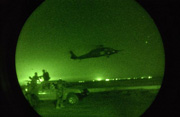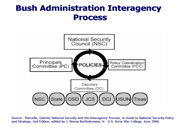

The Process
National security strategy, according to one expert, "needs an institutional guardian. The prime candidate to perform this function is the national security advisor and the NSC staff." 30 The NSC relies upon its staff, called the Executive Secretariat, to write the NSS, using input from various agencies of the federal government. This staff, currently (2006) numbering 225, works for the Assistant to the President for National Security Affairs, conducting the regular business of national security for the White House." 31
It should be noted, however, that there is no set of rules telling the NSC exactly how to develop a National Security Strategy. Each administration decides how it will use the NSC. Much depends upon the preferences of presidents and their National Security Advisors.
Another factor affecting how the NSS will be produced by the NSC is timing. Newly elected presidents may try to make broad changes in security policy, using the NSS to signal those changes to the new cabinet, those in Congress and foreign leaders. Such major shifts sometimes require significant amounts of time and political energy, which, in turn, may mean that the deadline for submitting the NSS may be missed.
Finally, when there are major changes in the international security environment, the NSC may require more time than usual to develop a new or substantially revised NSS. That is true because the greater the changes to the previous NSS, the more difficult it is to build a consensus within the relevant agencies.
The NSC uses what is called "the interagency process" to produce the NSS. This process can be used in different ways by different presidents. In general, however, here is how the interagency process is used by the NSC staff to produce the NSS. The most important thing to know about this process is that it is used because the NSS touches upon a range of important issues. That means that it has potentially significant implications for a number of governmental agencies, all of which must be involved in the process.
One student of the interagency process has suggested an "iron rule" of that process, "that no national security or international affairs issue can be resolved by one agency alone." 32 We should never underestimate the difficulties involved in combining the interests, outlooks and capabilities of the government agencies involved in foreign and security policy. The 1994 NSS may have gone through 21 drafts before it was released. 33
Committees and the interagency process
The NSC uses a set of "committees" to combine the views of the many agencies involved. These committees are displayed in the chart you see on your right.
Using guidance provided by the president´s National Security Advisor, these three committees are usually involved in producing the drafts of the NSS that will ultimately become policy. Policy Coordination Committees (some of which are organized by geographic region, others by policy function such as arms control and global environment) are interagency working groups. They are, in most (but not all) cases, central to the NSS interagency process. Their membership varies, but always consists of senior officials and substantive experts. They assist the NSC in generating consensus, as well as suggesting the outlines for portions of the NSS.
The Deputies Committee is "the senior sub-Cabinet interagency forum." 34 The members of this committee (deputies or under secretaries) direct interagency working groups to ensure that issues of importance have been adequately reviewed before drafts are presented to the next level up in a sequence of decision-making events.
Finally, the Principals Committee (PC) is available to provide a final and authoritative review. The PC is the most senior of the committees involved in this process. Its members are the Secretaries of State, Defense and Treasury, the National Security Agency, the Director of National Intelligence and the Chairman of the Joint Chiefs of Staff.
Analysis #3
The US Congress requires the president to produce a NSS each year. The National Security Council uses the interagency process to develop those strategies for the president. How is the strategy you have chosen developed within government? Is this strategy required by law? If so, can you identify that law? Does this law tell the government what it must include in the security strategy? Is this strategy produced on a regular schedule, e.g., annually?
Back to top



